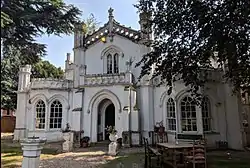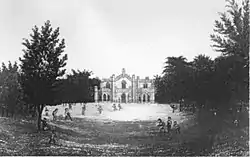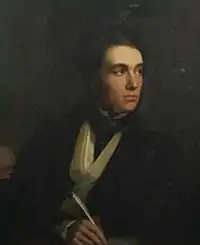Priory Hotel, Louth
The Priory Hotel in Louth, Lincolnshire is a building of historical significance and is listed on the English Heritage Register. It is described as an accomplished example of an early 19th Century villa of fine quality.[1] It was built from 1812 to 1818 by Thomas Espin, a talented topographical artist and draughtsman, amateur architect and mathematician. It was the home of several prominent people over the next two centuries. Today it is a hotel which provides accommodation, restaurant facilities and caters for special events.

Early residents


Thomas Espin (1767-1822) built the house between 1812 and 1818. He was the son of Thomas Espin (1729-1810) of Bullington Abbey and Elizabeth Butler. He was educated at Wragby School and later became a Fellow of the Society of Antiquarians. In 1790 he was appointed Master of the Mapletoft School in Louth. The official name of the school was the Mathematical, Architectural, Nautical and Commercial Academy. He had some cards printed to advertise his school.[2] When Thomas finished building the Priory in 1818 the school was moved here.
He was a talented artist and draughtsman and he and his brother John Espin travelled through Lincolnshire[3] making drawings of buildings many of which were turned into engravings and published in books.


His architectural talents were utilised by the Louth Corporation on several occasions. In 1805 he was asked to supervise the rebuilding of the belfry windows of St James’s Church. In 1808 he produced a plan of Louth and later designed a new Town Hall. In payment he was given the salvaged masonry and material from the former Town Hall and from the ruins of the 12th Century Louth Park Abbey.[4] He incorporated these into the building of the Priory. It is thought that his work on St James Church inspired some of the architecture of the Priory as the façade of structure with its two-storey central bay with pierced parapet, flanked by single-storey crenulated bays, strongly resembles the east front of the church.
Thomas died in 1822 and his obituary described him in glowing terms. It said:
"His reputation as an accurate delineator of nature and art is established by several beautiful prints which have been executed from his drawings and the taste displayed in the erection of his Priory Cottage at Louth and in the disposition of his pleasure grounds and plantations adjoining will render those objects lasting monuments of his classical skill and general knowledge of ancient architecture. He has left many friends who will long regret the loss of a character so admirable and so rarely met with in society."[5]
After his death his step brother William Espin moved into the Priory and took over the running of the school.[6] By 1831 Alexander Tallents Rogers was the headmaster.[7] He remained there for the next forty years.
Alexander Tallents Rogers (1804-1881) was born in 1804 in Nottingham. His father was Clement Rogers who was also a schoolmaster. He married Sarah Armston in 1828 at St Mary's Church, Nottingham. The 1841 Census records Alexander and his wife living at the Priory with their five children and thirty pupils. He also had two teaching assistants and several servants.
In 1870 he advertised the house for sale. The advertisement is shown. He and his wife moved to Penge and lived there for the rest of their lives.

Later residents
By 1878 Samuel Topliss (1825-1909) owned the Priory and lived there for the next thirty. He was a silk merchant and draper in Mercer Row, Louth. He became very wealthy and bought several properties. He was born in 1825 in Binbrook. He married twice. His first wife died in 1852 and four years later in 1856 he married Sarah Jane Chapman (1832-1894) who was the daughter of Joseph Chapman, a farmer in Grainthorpe. He was on the Louth Town Council and became a Manager of the Louth Savings Bank.[8] He died in 1909 and the house was sold to William Lacey.
William Lacey (1861-1948) was a wealthy stationer and draper. He was also the Mayor of Louth. He was born in Tuxford, Nottinghamshire in 1861. His wife’s name was Susan. They had no children but their niece Ivy Jones Lacey (1897-1984) lived with them for most of their lives. Ivy was a trained nurse. Susan died in 1943 and William in 1948. They were buried in London Road Cemetery in Louth and part of their memorial stone is an unusual wooden Celtic Cross which can be seen at this reference.[9] Ivy inherited The Priory and lived there until 1955 when she sold it and moved to a smaller house.
References
- English Heritage Register. Online reference
- Card for Thomas Espin's School. Online reference
- Howlett B. 1805 “A selection of Views in the county of Lincoln”. Online reference
- English Heritage Register. Online reference
- Stamford Mercury - Friday 20 December 1822, p. 3.
- Stamford Mercury - Friday 03 January 1823, p. 3.
- Stamford Mercury - Friday 22 July 1831, p. 3.
- Boston Guardian - Saturday 26 June 1909, p. 5.
- Burials and Beyond website. Online reference